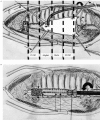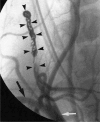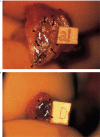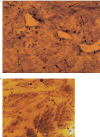Effects of endothelial injury on the rate of thrombus organization in canine carotid arteries occluded with microcoils
- PMID: 20591298
- PMCID: PMC3547412
- DOI: 10.1177/159101990300900102
Effects of endothelial injury on the rate of thrombus organization in canine carotid arteries occluded with microcoils
Abstract
Thrombus organization in canine carotid arteries occluded with platinum microcoils was studied to determine if endothelial injury created with a Xenon Chloride Excimer Laser (XEL) could acclerate endovascular fibrosis. Ten common carotid artery stumps were created in ten dogs. Each of four stumps were schematically divided into four longitudinally contiguous injury zones (thermal ablation injury, non-ablative injury, proximal and distal non-injury zones) to test the effects of ablative and non-ablative injury and to establish a set of internal controls that would account for proximity to circulating blood at the ostium of the occluded artery. Following XEL irradiation of the endothelium through an arteriotomy, each stump was embolized with microcoils. Four control stumps were subjected to sham laser procedures, and embolized in an identical fashion. Two additional stumps were embolized in the absence of sham surgery. Angiographic, gross and histologic analysis was performed after four weeks. Specimens of freshly clotted whole blood mixed with microcoils were used as an additional control. In irradiated stumps and non-irradiated stumps (sham and embolization only), angiography revealed no evidence of coil compaction or recanalization. In all irradiated stumps the thermal ablation zone contained fibrous tissue and neovascularity without unorganized thrombus. The other zones in the irradiated stumps were indistingnishable from each other and from all zones in the non-irradiated sham stumps, containing primarily unorganized thrombus. Stumps embolized in the absence of sham surgery were filled with material that was grossly and microscopically identical to specimens of freshly clotted whole blood containing microcoils. The results indicate that thermal ablation injury of the endothelium accelerates thrombus organization in canine carotid arteries occluded with platinum microcoils.
Figures








Similar articles
-
Treatment of experimental aneurysms using collagen-coated microcoils.Neurosurgery. 1995 Jan;36(1):133-9; discussion 139-40. doi: 10.1227/00006123-199501000-00017. Neurosurgery. 1995. PMID: 7708149
-
Mechanisms of occlusion and recanalization in canine carotid bifurcation aneurysms embolized with platinum coils: an alternative concept.AJNR Am J Neuroradiol. 2008 Apr;29(4):745-52. doi: 10.3174/ajnr.A0902. Epub 2008 Jan 17. AJNR Am J Neuroradiol. 2008. PMID: 18202238 Free PMC article.
-
Study on intraluminal embolization with microcoils treating traumatic pseudoaneurysms in common carotid artery in rabbits.Chin J Traumatol. 2004 Oct;7(5):266-70. Chin J Traumatol. 2004. PMID: 15363218
-
Embolization with autologous fibroblast-attached platinum coils in canine carotid artery aneurysms: histopathological differences from plain coil embolization.Invest Radiol. 2003 May;38(5):281-7. doi: 10.1097/01.RLI.0000064698.12359.79. Invest Radiol. 2003. PMID: 12750617
-
Endovascular management of internal carotid artery injuries secondary to endonasal surgery: case series and review of the literature.J Neurosurg. 2016 Nov;125(5):1256-1276. doi: 10.3171/2015.6.JNS142483. Epub 2016 Jan 15. J Neurosurg. 2016. PMID: 26771847 Review.
References
-
- Byrne J, Sohn M, Molyneux A. Five year experience in using coll embolization for ruptured intracranial aneurysms: outcomes and incidence of late rebleeding. Journal of Neurosurgery. 1999;90:656–663. - PubMed
-
- Cognard C, Weill A, et al. Long-term angiographic follow-up of 169 intracranial berry aneurysms occluded with detachable coils. Radiology: 1999;212:348–356. - PubMed
-
- Molyneux A, Ellison D, et al. Histological findings in giant aneurysms treated with Guglielmi detachable coils: report of two cases with autopsy correlation. Journal of Neurosurgery: 1996;83:129–132. - PubMed
-
- Manabe H, Fujita S, et al. Re-rupture of coil-em-bolized aneurysms during long-term observation. Journal of Neurosurgery. 1998;88:1096–1098. - PubMed
LinkOut - more resources
Full Text Sources

